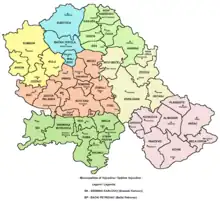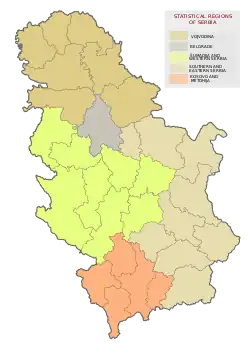Lazarevac
| |
|---|---|
   From top: Town center promenade, Memorial Church of St. Demetrius, Municipal Building | |
 Coat of arms | |
 Location of Lazarevac within the city of Belgrade | |
| Coordinates: 44°22′N 20°15′E / 44.367°N 20.250°E | |
| Country | |
| City | |
| Settlements | 34 |
| Government | |
| • Mayor | Bojan Stević (SNS) |
| Area | |
| • Urban | 17.87 km2 (6.90 sq mi) |
| • Municipality | 382.77 km2 (147.79 sq mi) |
| Elevation | 161 m (528 ft) |
| Population (2022 census)[3] | |
| • Urban | 27,635 |
| • Urban density | 1,500/km2 (4,000/sq mi) |
| • Municipality | 55,146 |
| • Municipality density | 140/km2 (370/sq mi) |
| Time zone | UTC+1 (CET) |
| • Summer (DST) | UTC+2 (CEST) |
| Postal code | 11550 |
| Area code | +381(0)11 |
| ISO 3166 code | SRB |
| Car plates | BG |
| Website | www |
Lazarevac (Serbian Cyrillic: Лазаревац, pronounced [lazareʋat͡s]) is a municipality of the city of Belgrade. As of 2022, the town has a total population of 27,635 inhabitants, while the municipal area has a total of 55,146 inhabitants.
Its name stems from the name of medieval Serbian ruler Prince Lazar Hrebeljanović.[4]
History
During the Interbellum, there was an auxiliary military airfield in Lazarevac, part of the air defense of the state capital, Belgrade.
On 7 April 1941, during the German bombing of Belgrade, air force unit "Arad", employing 60 Štuka airplanes bombed the airfield in an effort to destroy as many Yugoslav planes as possible. A majority of planes, used for training flights, were either destroyed or demolished; a total of nine airmen were killed in action. The Memorial Church of St.Demetrius, with ossuary, was also damaged in the attack.
The area of the former airfield is today occupied by the health center "Dr Đorđe Kovačević" and the Special Hospital for the endemic nephropathy, but neither the location nor the graves are marked in memory of the 1941 events. In 1984 one of the town streets was named after the killed airmen, albeit erroneously: instead of "Nine airmen", the street was named "Six airmen". In January 2018, dedication of the memorial plaque on the location of the former airfield was announced.[5]
In 1971, the municipality of Lazarevac, along with Mladenovac, was annexed to the city of Belgrade.
Settlements
Aside from the town of Lazarevac, the municipality comprises the following settlements:[6]
The village of Sakulja was resettled in 1984. It was officially abolished in October 2019 and its territory was annexed to the neighboring Junkovac.[7]
Demographics
| Year | Pop. | ±% p.a. |
|---|---|---|
| 1948 | 36,377 | — |
| 1953 | 38,794 | +1.29% |
| 1961 | 43,906 | +1.56% |
| 1971 | 45,675 | +0.40% |
| 1981 | 51,068 | +1.12% |
| 1991 | 58,882 | +1.43% |
| 2002 | 58,511 | −0.06% |
| 2011 | 58,622 | +0.02% |
| 2022 | 55,146 | −0.55% |
| Source: [8] | ||
The municipality of Lazarevac has a total population of 55,146 inhabitants, according to the 2022 census results.
Ethnic groups
The ethnic composition of the municipality (as of 2022):[9]
| Ethnic group | Population |
|---|---|
| Serbs | 51,582 |
| Romani | 668 |
| Yugoslavs | 83 |
| Macedonians | 55 |
| Montenegrins | 52 |
| Russians | 29 |
| Croats | 28 |
| Muslims | 19 |
| Romanians | 16 |
| Others | 141 |
| Undeclared/Unknown | 2,473 |
| Total | 55,146 |
Economy
Lazarevac is the home to the Serbian largest coal mining and smelting complex RB Kolubara.
The following table gives a preview of total number of registered people employed in legal entities per their core activity (as of 2018):[10]
| Activity | Total |
|---|---|
| Agriculture, forestry and fishing | 118 |
| Mining and quarrying | 9,094 |
| Manufacturing | 2,944 |
| Electricity, gas, steam and air conditioning supply | 748 |
| Water supply; sewerage, waste management and remediation activities | 759 |
| Construction | 824 |
| Wholesale and retail trade, repair of motor vehicles and motorcycles | 2,153 |
| Transportation and storage | 575 |
| Accommodation and food services | 693 |
| Information and communication | 105 |
| Financial and insurance activities | 205 |
| Real estate activities | 7 |
| Professional, scientific and technical activities | 355 |
| Administrative and support service activities | 1,726 |
| Public administration and defense; compulsory social security | 299 |
| Education | 978 |
| Human health and social work activities | 773 |
| Arts, entertainment and recreation | 169 |
| Other service activities | 188 |
| Individual agricultural workers | 102 |
| Total | 22,815 |
Education
The town has 3 elementary schools, OŠ Vojislav Voka Savić, OŠ Dule Karaklajić, and OŠ Knez Lazar, which together have about 3000 students. There are also 2 high schools, Kolubara Technical School and the Lazarevac Gymnasium.
Attractions
One of the main attractions in Lazarevac is the Church of St. Demetrius. It is essentially a mausoleum, a main memorial room, built in the memory of Serbian and Austro-Hungarian army soldiers that were killed at the Battle of Kolubara. 40,000 killed soldiers, both Serbian and Austro-Hungarian, were buried in the memorial ossuary of the church's crypt. It is the largest World War I necropolis in Serbia.[11][12] "The Committee to raise a memorial church and crypt in Lazarevac" was established in order the build the church. In the 1937 Committee was disbanded and "The Society for raising a memorial church with crypt in Lazarevac" was formed instead, led by a priest Borivoje Đorđević. Finally, the temple was built by the Russian émigré architect Ivan Afanasjevič Rik between 1938 and 1941.[13] In the architectural and urban environment of Lazarevac, the temple stands as a significant achievement of interwar Serbian church architecture.[14]
There is also a Modern gallery in the town, with the rich collection of paintings, graphics and sculptures, the "Kamengrad" ("Stoneville"), a park enriched with the stone sculptures chiseled by Bogosav Živković, and a Cultural Center. Outside of the town there are three wooden churches from the 18th century, a spring of natural mineral water and several archaeological finds. Other touristic features in the vicinity of Lazarevac include the Ćelije monastery and the Vrače hill, where Dimitrije Tucović, Serbian socialist theorist, was killed in November 1914 during the Battle of Kolubara.[11][15]
In Baroševac on the bank of the Kolubara grow a grove of giant sequoia trees which were brought from California to be studied and planted in Europe. The trees had only reached a height of 30m as of 2011, and are continuing to be studied as they develop in this manufactured habitat.[16]
There is a game hunting ground "Kolubara" in the municipality.[17]
 Town center street promenade
Town center street promenade Dimitrije Tucović Library
Dimitrije Tucović Library Culture center
Culture center Retail park
Retail park Lake Očaga
Lake Očaga
See also
References
- ↑ "Municipalities of Serbia, 2006". Statistical Office of Serbia. Retrieved 2010-11-28.
- ↑ "Насеља општине Лазаревац" (PDF). stat.gov.rs (in Serbian). Statistical Office of Serbia. Retrieved 23 October 2019.
- ↑ "2022 Census of Population, Households and Dwellings: Ethnicity (data by municipalities and cities)" (PDF). Statistical Office of Republic Of Serbia, Belgrade. April 2023. ISBN 978-86-6161-228-2. Retrieved 2023-04-30.
- ↑ "Kako je Lazarevac dobio ime". Moja Srbija (in Serbian). mojasrbija.rs. 12 August 2014. Retrieved 10 September 2017.
- ↑ Branka Vasiljević (31 January 2018). "Bombardovanje aerodroma u Lazarevcu zaboravljena priča" [Lazarevac airfield bombing - forgotten story]. Politika (in Serbian). p. 17.
- ↑ "Насеља општине Лазаревац" (PDF). stat.gov.rs (in Serbian). Retrieved 4 April 2019.
- ↑ Branka Vasiljević (6 October 2019). "Sakulja i Ropočevo izbrisani s mape grada" [Sakulja and Ropočevo erased from the city map]. Politika (in Serbian).
- ↑ "2011 Census of Population, Households and Dwellings in the Republic of Serbia" (PDF). stat.gov.rs. Statistical Office of the Republic of Serbia. Archived from the original (PDF) on 14 July 2014. Retrieved 11 January 2017.
- ↑ ETHNICITY - Data by municipalities and cities (PDF). Belgrade, Serbia: Statistical Office of the Republic of Serbia. 2023. pp. 34–35. ISBN 9788661612282. Archived from the original (PDF) on 2023-11-22. Retrieved 2023-11-23.
- ↑ "MUNICIPALITIES AND REGIONS OF THE REPUBLIC OF SERBIA, 2019" (PDF). stat.gov.rs. Statistical Office of the Republic of Serbia. 25 December 2019. Retrieved 28 December 2019.
- 1 2 Dimitrije Bukvić (12 December 2008), "Kopovi "Kolubare" - biser industrijskog turizma", Politika (in Serbian)
- ↑ Jelena Čalija (22 December 2018). "Војни меморијали - заборављени сведоци страдања у Великом рату" [Military memorials - forgotten witnesses of the Great War suffering]. Politika (in Serbian). p. 08.
- ↑ Spomenici kulture
- ↑ Cultural monument of outstanding value, Memorial Church in Lazarevac
- ↑ Dimitrije Bukvić (26 March 2011). "Turistički prsten na sat od kruga "dvojke"" (in Serbian). Politika.
- ↑ Novosti - Lazarevac: High redwood sprouting from coal (Serbian)
- ↑ Branka Vasiljević (5 August 2018). "Lovci u Beograd stižu porodično" [Hunters travel to Belgrade with their families]. Politika (in Serbian).


